
François Auguste René Rodin was a French sculptor generally considered the founder of modern sculpture. He was schooled traditionally and took a craftsman-like approach to his work. Rodin possessed a unique ability to model a complex, turbulent, and deeply pocketed surface in clay. He is known for such sculptures as The Thinker, Monument to Balzac, The Kiss, The Burghers of Calais, and The Gates of Hell.

Camille Rosalie Claudel was a French sculptor known for her figurative works in bronze and marble. She died in relative obscurity, but later gained recognition for the originality and quality of her work. The subject of several biographies and films, Claudel is well known for her sculptures including The Waltz and The Mature Age.

Antoine Bourdelle, born Émile Antoine Bordelles, was an influential and prolific French sculptor and teacher. He was a student of Auguste Rodin, a teacher of Giacometti and Henri Matisse, and an important figure in the Art Deco movement and the transition from the Beaux-Arts style to modern sculpture.
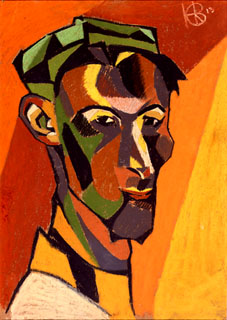
Henri Gaudier-Brzeska was a French artist and sculptor who developed a rough-hewn, primitive style of direct carving.

Gaston Lachaise was a French-born sculptor, active in America in the early 20th century. A native of Paris, he is most noted for his robust female nudes such as his heroic Standing Woman. Gaston Lachaise was taught the fundamentals of European sculpture while living in France. While still a student, he met and fell in love with an older American woman, Isabel Dutaud Nagle, then followed her after she returned to America. There, he became profoundly impressed by the great vitality and promise of his adopted country. Those life-altering experiences clarified his artistic vision and inspired him to define the female nude in a new and powerful manner. His drawings, typically made as ends in themselves, also exemplify his remarkably new treatment of the female body.
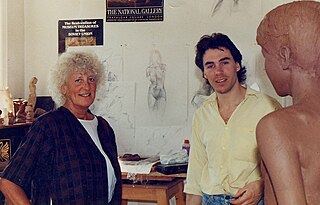
Dame Elisabeth Jean Frink was an English sculptor and printmaker. Her Times obituary noted the three essential themes in her work as "the nature of Man; the 'horseness' of horses; and the divine in human form".
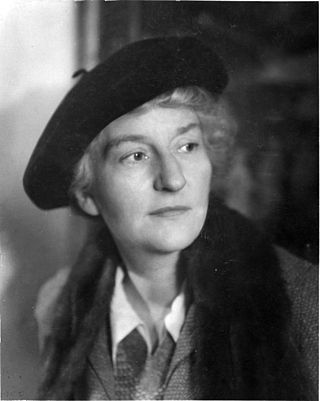
Malvina Cornell Hoffman was an American sculptor and author, well known for her life-size bronze sculptures of people. She also worked in plaster and marble. Hoffman created portrait busts of working-class people and significant individuals. She was particularly known for her sculptures of dancers, such as Anna Pavlova. Her sculpture series of culturally diverse people, entitled Hall of the Races of Mankind, was a popular permanent exhibition at the Field Museum of Natural History in Chicago. It was featured at the Century of Progress International Exposition at the Chicago World's Fair of 1933.

Wilhelm Lehmbruck was a German sculptor. One of the most important of his generation, he was influenced by realism and expressionism.

The Burghers of Calais is a sculpture by Auguste Rodin in twelve original castings and numerous copies. It commemorates an event during the Hundred Years' War, when Calais, a French port on the English Channel, surrendered to the English after an eleven-month siege. The city commissioned Rodin to create the sculpture in 1884 and the work was completed in 1889.

Leonard Baskin was an American sculptor, draughtsman and graphic artist, as well as founder of the Gehenna Press (1942–2000). One of America's first fine arts presses, it went on to become "one of the most important and comprehensive art presses of the world", often featuring the work of celebrated poets, such as Sylvia Plath, Ted Hughes, Anthony Hecht, and James Baldwin side by side with Baskin's bold, stark, energetic and often dramatic black-and-white prints. Called a "Sculptor of Stark Memorials" by the New York Times, Baskin is also known for his wood, limestone, bronze, and large-scale woodblock prints, which ranged from naturalistic to fanciful, and were frequently grotesque, featuring bloated figures or humans merging with animals. "His monumental bronze sculpture, The Funeral Cortege, graces the Franklin Delano Roosevelt Memorial in Washington, D.C."
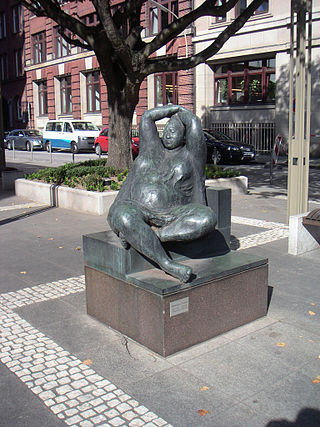
José Jesús Francisco Zúñiga Chavarría was a Costa Rican-born Mexican artist, known both for his painting and his sculpture. Journalist Fernando González Gortázar lists Zúñiga as one of the 100 most notable Mexicans of the 20th century, while the Encyclopædia Britannica calls him "perhaps the best sculptor" of the Mexican political modern style.

Nancy Graves was an American sculptor, painter, printmaker, and sometime filmmaker known for her focus on natural phenomena like camels or maps of the Moon. Her works are included in many public collections, including those of the National Gallery of Art, the Brooklyn Museum of Art, the Smithsonian American Art Museum, the National Gallery of Australia (Canberra), the Des Moines Art Center, Walker Art Center (Minneapolis), and the Museum of Fine Arts. When Graves was just 29, she was given a solo exhibition at the Whitney Museum of American Art. At the time she was the youngest artist, and fifth woman to achieve this honor.
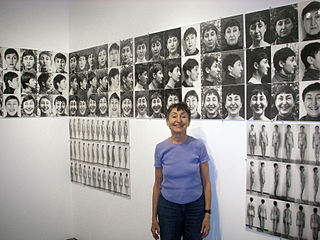
Athena Tacha, is a multimedia visual artist. She is best known for her work in the fields of environmental public sculpture and conceptual art. She also worked in a wide array of materials including stone, brick, steel, water, plants, and L.E.D. lighting. photography, film, and artists’ books. Tacha's work focused on personal narratives, and often plays with geometry and form.
Luis Ortiz Monasterio was a Mexican sculptor noted for his monumental works such as the Monumento a la Madre and the Nezahualcoyotl Fountain in Chapultepec Park. His work was recognized in 1967 with the Premio Nacional de Artes and was a founding member of the Academia de Artes.

Patricia Cronin is a New York-based feminist cross-disciplinary artist. Since the early-1990s, Cronin has garnered international attention for her photographs, paintings and sculptures that address contemporary human rights issues. Cronin's conceptual artistic practice transits across many aesthetic platforms addressing social justice issues of gender, sexuality and class, including: lesbian visibility, feminist art history, marriage equality and international rights of women and LGBTQ+ people. She subverts traditional art images and forms in a wide range of two and three-dimensional time-honored artists' materials and breathes new life into these images and forms by injecting her specific political content. Her critically acclaimed statue, "Memorial To A Marriage", is the first and only Marriage Equality monument in the world. A 3-ton Carrara marble mortuary sculpture of her life partner and herself was made before gay marriage was legal in the U.S., and has been exhibited widely across the country and abroad. Cronin began her career working for the Anne Frank Stichting (Foundation)Archived 2015-10-25 at the Wayback Machine in Amsterdam installing the traveling exhibition "Anne Frank in the World" in Europe and the U.S. Giving presence to female absence is a consistent thread that runs through and connects each body of work.

Diana Widmaier Picasso is a French art historian specialized in modern art, living in Paris.
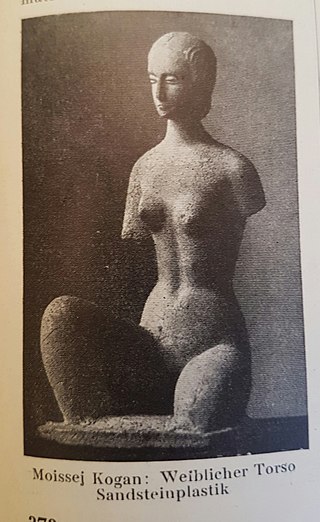
Moissey Kogan was a Bessarabian Jewish medalist, sculptor and graphic artist who spent much of his time in Paris and travelled throughout Europe. He specialised in creating sculptures and graphic art based on the female form. The Moissey Kogan Catalogue Raisonné of Sculpture & Prints Project is in the process of compiling a scholarly catalogue raisonné of Moissey Kogan’s sculpture and prints, and is preparing a comprehensive monograph on the artist’s life and career. The Moissey Kogan Archive of the European Cultural Foundation, in Bonn, collects and captures the entire work of the artist. Kogan is sometimes confused with Russian painter Moisey Kogan (1924–2001), who specialized in colorful oil paintings of Russian village life, landscapes, churches etc.
Ethel Rosenfield was a Polish-born Canadian sculptor who lived in Montreal, Quebec. After enrolling in art classes in her mid-forties, she began working primarily in limestone and marble, exploring "organic forms, abstract or schematized, the latter representing faces and female bodies". Rosenfield co-founded the Quebec Sculptors' Association in 1962, and her work was exhibited at the Rodin Museum, Expo 67, the Montreal Museum of Fine Arts, and multiple Canadian universities. Her sculptures are held in permanent collections at Concordia University, the Musée d'art contemporain de Montréal, and the Storm-King Art Centre.
Holly Trusted is a historian of European sculpture. Previously Senior Curator of Sculpture at the Victoria and Albert Museum she is known in particular for her work on British and Spanish sculpture and was the lead curator for the Victoria and Albert Museum Cast Courts. Since January 2019, she has been an Honorary Senior Research Fellow at the Victoria and Albert Museum. She was Honorary Vice-President of the Society of Antiquaries of London in 2018–19.
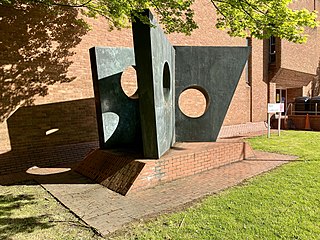
Three Obliques (Walk In) is a 1968 sculpture by Barbara Hepworth. Three casts exist; two are in private collections and a third is displayed outside the Cardiff University School of Music in Cardiff, Wales. It is cast in bronze on a monumental scale.


















